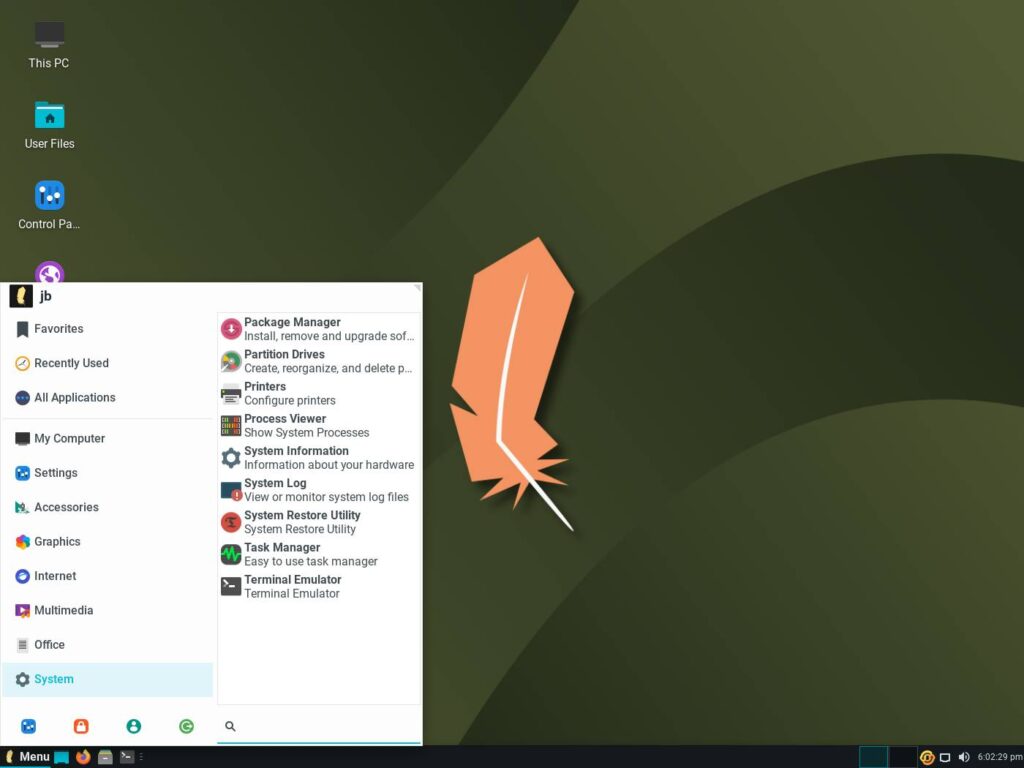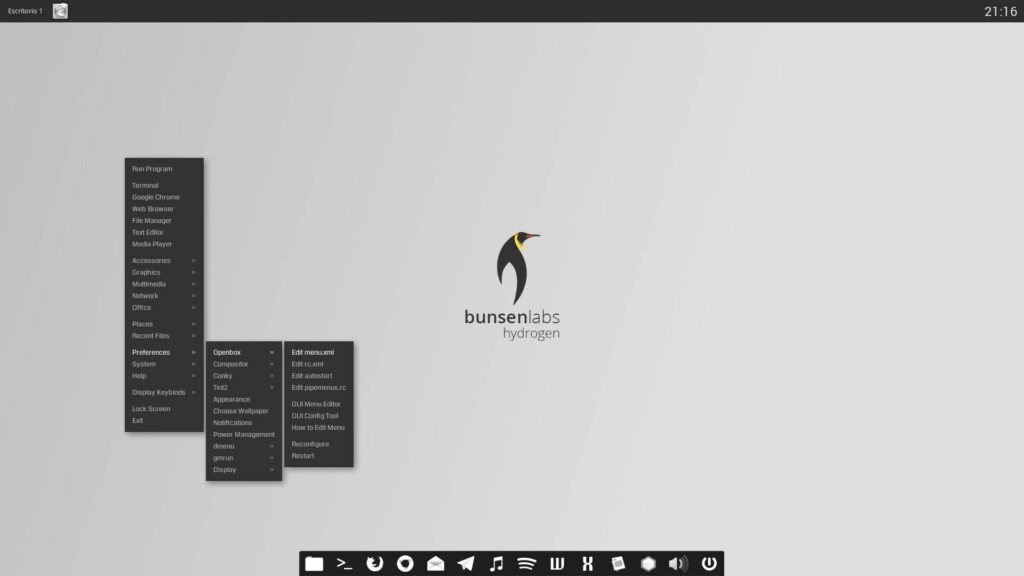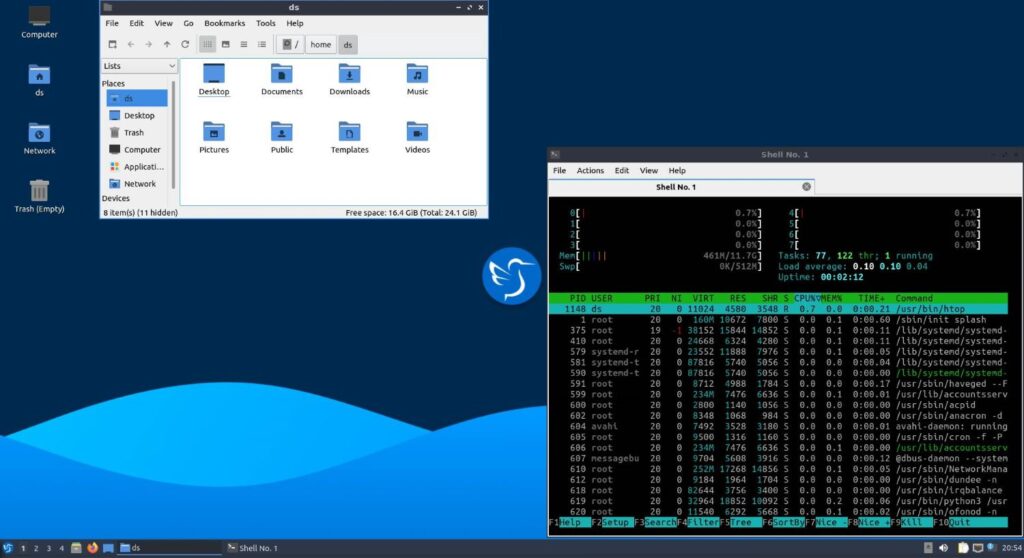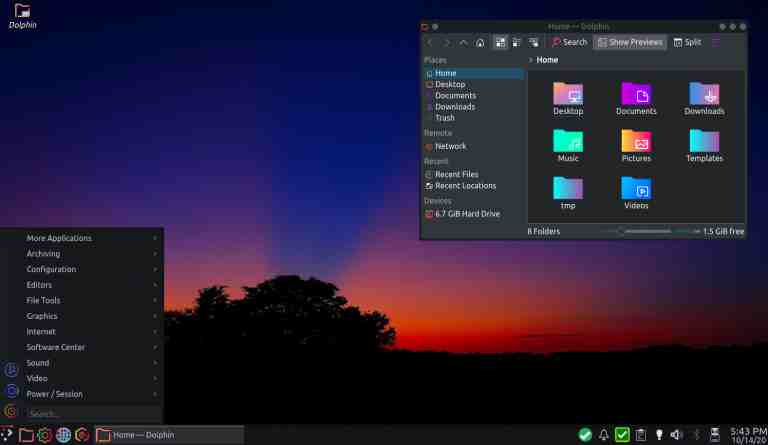List of the Best Lightweight Linux Distros (2022)
Windows is the most popular operating system and it has its own advantages and disadvantages. On the other hand, there are some other users that are big fans of Linux OS. Linux is an open-sourced operating system but Windows is a closed-sourced and commercial operating system.
Both operating systems are actively being developed and many developers work to make compatible tools for them. However, the number of available tools and software for Windows is much bigger than any other operating system. You can easily find a certain software for your Windows but it’s not always possible to find alternatives for Linux.
One advantage that Linux has over Windows is the number of choices you have while selecting your OS. There are hundreds of different Linux distributions out there. Although most of them are based on a few number of Linux distros, but the interface and some functionalities of them could be much different from each other.
Another bold feature of running Linux over Windows is the security. As Linux is an open-sourced operating system, all developer around the world work hard on it to fix its vulnerabilities. Privacy is another concern of Windows users while Linux users have no or minimum amount of issue regarding privacy.
Another advantage of choosing Linux over Windows is its compatibility with most of new and old computers. If you own an old computer or laptop that can not run new versions of Windows that are high demanding hardware-wise, you can still install Windows 98 on it; but no one takes that risk because in addition to not being able to run most recent software, you are under a great amount of risk because it’s not secure at all today.
You can not run Windows 11 on a computer with 512MB of RAM. Even if you manage to install it, you can not get any benefit from that in reality. However, there are many lightweight Linux distros that can be successfully installed and operate on a system with even 256 MB of RAM. Although you don’t get the latest polished beautiful interface from that, but you can still run basic functions like typing, surfing the web, running some low-demanding games and etc. on that system.
You may have a computer with 4GB of RAM or more and still the agility of Windows 10 or 11 may not satisfy you; this is another reason that some users may prefer to choose Linux over Windows. In such cases you can install some light (lite) versions of Windows but these are not official versions and installing them is risky. The good news is that there are many official lightweight Linux distros which are actively being developed.
As mentioned before, there are so many lightweight Linux distributions out there but we are just going to give you a list of the most beautiful, lightweight Linux distros so that you can decide with no confusion.
Best Lightweight Linux Distros
1. Linuxlite

Linuxlite is one of the very easy-to-use, clean and beautiful lightweight Linux distros that is based on Debian and Ubuntu LTS (long-term support). It is so lightweight and uses customized XFCE desktop environment which is a very fast desktop environment.
Minimum system requirements of Linuxlite are:
- CPU: 1 GHz processor
- RAM: 768MB RAM
- STORAGE: 8 GB
Linuxlite has LibreOffice pre-installed and you can easily edit your current Office documents and make new ones. Photo editing, viewing software (GIMP), media player (VLC), Internet web browser (Firefox) and email management tool (Thunderbird) are also ready to use when you install Linuxlite. Linux Lite comes with Lite Software and Synaptic Package Manager.
2. Zorin OS Lite
Zorin OS is a popular, and polished designed distribution of Linux which is based on Ubuntu. Like most other Linux distors you can try it before installing by running it from a USB drive.
Zorin OS comes with a huge number of apps from the Software store. You can also download and run .deb or .AppImage executables. Installing WineHQ enables you to install and run many Windows applications (.Exe and .MSI) on Zorin OS. Zorin OS Lite can be installed on every system that at least has:
- CPU: 1 GHz Single Core – Intel/AMD 64-bit processor
- RAM: 1 GB
- Storage: 10 GB
- Display: 1024 × 768 resolution
Zorin OS Lite is written using C, C++, Python, D, Java languages and it is based on XFCE desktop environment and if you want to have a dual boot and install Zorin OS lite alongside Windows or Mac OS, it is possible and you can easily do that. Zorin OS Pro has more layouts which makes it similar to Windows or Mac OS. It is based on GNOME desktop environment but it requires more hardware resources to install and run.
3. Q4OS

Q4OS is a fast Linux operating system based on Debian with a lot of customizations and optimizations to make a friendly environment for its users.
Q4OS doesn’t come with a lot of preinstalled applications to offer the best available performance and doesn’t let users customize and install tools and software on it according to their needs. However, it guarantees that you get a long-term support to be always UpToDate with the latest security and features.
Q4OS has a simple design to work on low-end computers but you can easily go to software center and install Lookswitcher to get additional themes and switch between them by one click.
It is one of the lightweight Linux distros that you can have multiple desktop environments at the same time and switch between them.
Q4OS can be easily installed alongside Windows using Windows installer tool. It allows you to install Q4OS like a regular Widows application in Windows filesystem folder (You don’t need a separate partition to install it) and every time you restart your Windows, you will have the option of choosing Windows or Q4OS. The full guide is available here.
Q4OS offers 2 different desktop environments and you can choose according to your taste. Plasma and Trinity. Trinity needs much lower hardware resources. You’ll need the below requirements for running Q4OS:
| Q4OS Hardware Requirements | CPU | RAM | Hard Disk Space |
| Plasma desktop | 1 GHz | 1 GB | 5 GB |
| Trinity desktop | 300 MHz | 256 MB | 3 GB |
4. Trisquel (Mini)
Another distribution of Linux is based on Ubuntu and has 4 different editions including: Trisquel (MATE desktop), Trisquel Mini (LXDE desktop), Triskel (KDE desktop) and Trisquel Sugar TOAST (Sugar e-learning environment – mainly used by children). It is a good operating system for home, enterprise and educational centers.
It comes with some prebuild applications like Firefox browser and some other tools which are basic requirements for every system. It has a package manager to offer you the software you may need to add to your computer. Like many other Linux distors, Trisquel has an active community to help you when you need additional support through its own forum.
Minimum system requirements for running Trisquel mini:
- CPU: Intel Pentium 2 and AMD K6 processors
- RAM ( 32bit: 128 MB and 64bit: 256 MB)
- 5 GB free hard disk space
5. Lithium

Lithium from BunsenLabs is one of the many lightweight Linux distros based on Debian with a nice looking interface and standard features that any user is looking for. It has a live CD and installation media for amd64 (x86-64) architectures and i386 (i686) architectures.
Lithium Linux distro uses main Debian repository and in addition to that it lets you select and install apps from BunsenLabs project repository. Installing Chromium, LibreOffice, Brasero, K3b, editors, media players, Gimp and some other software has been made easy by using Install Selected Packages from start menu.
Minimum system requirements for running Lithium are 1 GB of RAM (2 GB is recommended) and 20 GB of hard disk.
It uses minimum hardware resources and can be run on almost any computer. A fresh boot of Lithium uses nearly 500 MB of RAM.
6. Peppermint OS

Another XFCE desktop environment based distro and one of the best known lightweight Linux distros based on Debian that brings you a very fast experience with different layouts including light and dark themes.
Peppermint Linux conducts good tradeoff installing required software and refusing to stuff the OS with bloatware. Peppermint can be run on almost any old and all new hardware and the minimum system requirements to run and try Peppermint Linux are 1GB of RAM and 5 GB of hard disk space and X86 based CPU.
7. LXLE
LXLE is a fast and minimum-required OS that is based on Lubuntu and Lubuntu is based on Ubuntu OS and LXDE desktop environment. These combinations make you sure about the performance of this lightweight Linux distro.
The main focus of the developer team is to bring a fast OS for old computers that have limited amount of hardware resources. To support maximum possible hardware and software, LXLE only uses LTS of Ubuntu to speedup the OS as much as possible; it also uses Lubuntu.
It is equipped with different desktop layouts, has more than 100 bundled wallpapers, has random & Interval wallpaper changer and uses LXDE window manager. LXLE boots fast even on old computers and has access to the latest stable software releases.
You can freely run LXLE on any computer that has at least Pentium 3 processor, 512 MB of RAM and 8 GB of disk space.
8. Lubuntu

Lubuntu is one of the lightweight Linux distros based on Ubuntu and focuses on speed using Qt technologies for creating user interfaces. By default, Lubuntu uses Arc theme and the Papirus icons to give you vibrant colors without compromising speed.
Pre-installed applications like office applications, PDF reader, image editor, music and video players, etc. make you independent from searching and installing more software but if you need any, you can do that through software center. You can search for software name or format of file you are dealing with.
Lubuntu team offers many ISOs for standard PCs, laptops, Raspberry Pi, and etc. Minimum system requirements for Lubuntu:
- CPU: Pentium 4 or Pentium M or AMD K8
- RAM: 512 MB for running local installed apps and 1 GB for using internet Services
9. Puppy Linux
Puppy Linux is another famous member of lightweight Linux distros and its market target is home-user computers. Puppy Linux is so lightweight that runs on almost any system.
Puppy Linux family has distributions with many flavors and you can download your favorite one according to your taste. Different flavors are meant to run for both old and new computers.
Puppy Linux is so light (less than 300 MB) and includes most software you need to run your daily tasks by. The best definition for Puppy Linux would be a collection of multiple Linux distributions, built on the same shared principles, and built using the same set of tools.
The main Puppy Linux distributions are:
- Official Puppy Linux distributions: maintained by Puppy Linux team for general purpose
- Woof-Built Puppy Linux distributions: developed for special needs and appearances, also targeted for general purpose with some additional or modified packages
- Unofficial derivatives (“puplets”): are usually remasters maintained by Puppy Linux enthusiasts
Minimum system requirements to run Puppy Linux are:
- CPU : Pentium 900 MHz
- RAM : 300 MB RAM
10. antiX

antiX is one the fastest lightweight Linux distros that is based on Debian. It can be installed using Live CD. It has a “antiX Magic” desktop environment that is mainly developed for older computers.
It boosts very fast and you can use it for your daily tasks as well as rescuing your computer when you can’t login to your main operating system (using live CD).
It comes in different versions for 32bit architecture and “net distro” version for both 32 and 64 bit architectures.
AntiX uses IceWM together with the Rox file manager to work as fast as possible. The good news is that antiX has Synaptic package manager that allows you to have access to thousands of software.
For customizations you can edit themes, menus, wallpaper and some other parts of the OS. The minimum hardware requirements to run antiX are:
- RAM: 256 MB
- Hard Disk Space: 5 GB
11. Tiny Core
A really tiny Linux distribution that is only 11 MB for Tiny Core and 16 MB for Core Plus version. It is highly modular and can be customized according to your needs. Tiny core uses FLWM Window Manager.
If you consider installing Tiny Core please keep in mind that Tiny Core is a very minimal Linux environment and doesn’t include software bundles and it only offers you core of Linux and you should know how to configure it and install applications you need. Tiny Core Linux is not recommended for beginner users.
You can run Tiny Core Linux on any computer which has minimum hardware of:
- CPU: i486DX processor (Pentium II and more is recommended)
- RAM: 46 MB (128 MB and more recommended)
12. SliTaz

SliTaz is a high performance and independent Linux operating system for desktops and servers; it uses Linux Kernel and GNU software. You can totally run it from memory, CD-ROM or USB. One good feature is that you can save all your data and settings while you run it using live system.
SliTaz is suitable for versatile devices including: old computers, powerful servers and small ARM devices such as the Raspberry Pi. Some main features of SliTaz Linus are:
- Very small in size (ISO image is less than 40 MB)
- Ready to use Web/FTP server
- Multiple browser options: Midori, Firefox or Lynx
- Database engine with SQLite
- Create, edit or burn CD or DVD images
Minimum amount of RAM required to run SliTaz is 192 MB!
13. KNOPPIX
KNOPPIX is a bootable and portable disc with a collection of GNU/Linux software that supports a wide range of hardware including graphic card, sound cards and etc. It’s a portable Linux distribution that can be run from CD or USB flash drives.
More than a thousand packages are included in CD edition and more than 2500 packages are available in DVD edition. By default KNOPPIX uses LXDE desktop environment. There are many media players, document viewers graphic tools and etc.
KNOPPIX can be run on different hardware and it varies. Minimum hardware required for each application is as below:
- CPU: Intel/AMD (i486 or later)
- RAM (32 MB for text mode, 512 MB for graphics mode LXDE, 1 GB to use the web browser and other demanding software and 2 GB is recommended and good enough for most applications)
14. PCLinuxOS

PCLinuxOS is nice-looking and one the simplest lightweight Linux distros available as Live CD, DVD and USB ISO image which can be installed on and X64 systems only (The x86 version was discontinued in 2016). By installing PCLinuxOS you have access to Advanced Packaging Tool (or APT), Debian package management system and Synaptic package manager to add features to your operating system.
PCLinuxOS supports more than 85 languages. You can use PCLinuxOS for all your online tasks including surfing the web, messaging, website management and etc.
PCLinuxOS has media player tools to work with your MP3 and videos files as well as photo editing software. LibreOffice fulfills all your needs for dealing with documents and creating Office files. Minimum hardware requirements are:
- CPU: Any Intel/AMD processor
- RAM: 512 MB (2 GB and more is recommended)
- Hard Disk space: 12 GB (20+ GB is recommended)
- Graphics card: nVidia, ATI, Intel, SiS, Matrox, VIA
- Sound card: any Sound Blaster, AC97 or HDA compatible card
15. Xubuntu
Xubuntu is a lightweight Linux distribution which uses XFCE desktop environment based on Ubuntu with all features you need to get out of your computer. It is useable by both low-end and high-end computers and every user with every level of Linux knowledge can get benefit from Xubuntu.
Synaptic Package Manager lets Xubuntu users choose between thousands of software. Xubuntu needs much less hardware than Ubuntu’s GNOME desktop environment. Minimum system requirements for Xubuntu are:
- CPU: Any Intel or AMD 64-bit processor (1.5Ghz Dual Core processor is recommended)
- RAM: 1 GB (2 GB or more is recommended)
- Hard Disk Space: about 9 GB free space for installing Xubuntu (20 GB is recoomended)
16. Void
Void is one of the lightweight Linux distros; it is based on the monolithic Linux kernel and uses the X Binary Package System (XBPS) package manager.
Void is a very fast and independent distribution and isn’t based on other common distros and supports both the musl and GNU libc implementations. Xbps is the native system package manager for Void Linux. Minimum system requirements vary for 32bit and 64 bit architectures.
| Hardware Requirements | CPU | RAM | Hard Disk |
| 32bit | Pentium 4 CPU (SSE2) | 96 MB | 350 MB |
| 64bit | EM64T | 96 MB | 350 MB |

